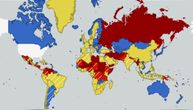Seismologist tells Telegraf.rs: We can expect a strong earthquake in Sumadija area in next 10 years
Seismic activity is slowly accumulating in the area of Sumadija (central Serbia) and a strong quake can be expected as early as in about ten years
A series of earthquakes that last weekend hit Mladenovac, a suburban municipality of Belgrade, indicate that the area where they have not been registered for a long time is active, that seismic activity has accumulated there and that in the coming period, maybe in ten years, a strong shock can be expected in Sumadija, seismologist Slavica Radovanovic has told Telegraf.rs.
The M3.7 earthquake in Mladenovac was the fourth strongest in the area of Sumadija since 1929. She pointed out that there is no reason to panic, that construction in that part of Serbia should be good, but that these earthquakes should be a warning for future building standards, and to reinforce the existing structures that need that work done.
"They only indicate that this area is active, that there has simply been no earthquake of such magnitude for a long time, for about 20 years. The last ones hit near Barajevo in 2001, and a little before that similar magnitudes were recorded near Azanja and Velika Krsna. All this shows that this space is active and that in it, where strong earthquakes were happening a hundred years ago, they can be generated again," Slavica Radovanovic explained for Telegraf.rs.
While looking at the map of earthquakes in Sumadija, she recalled that in 1994 there was an M3.9 one in Smederevska Palanka, while the one in Barajevo in 2001 was M3.7.
"In 1950, there was an M3.6 earthquake all the way south, near Kraljevo. So we haven't had such a strong earthquake in the last 70 years, with the exception of the Rudnik quake area. We are only looking at the area north of Rudnik towards Belgrade. Before that, there was an M3.9 earthquake near Smederevska Palanka... So, this was the fourth strongest earthquake in the area of Sumadija in all these years, decades, and there have been two in 20 years," Slavica Radovanovic told our portal.
She explained that this means that seismic energy is slowly accumulating in that area.
"Most likely, that big earthquake will not happen soon, it should be preceded by some greater acceleration. That should be monitored now. I would not say that it will happen soon, but a period of about 10 years is a logical amount of time to expect a strong earthquake in the area of Sumadija," she explains.
When asked how good it is that it started with, conditionally speaking, milder earthquakes, she explains:
"They only testify that it is starting there... This shows that there is already so much accumulated energy that when one happens, it can provoke another. It's like when people are in the mood for an argument, it's enough for one to start, then the others will follow."
Does a strong shock have to happen
Asked if there must be a strong earthquake in the Sumadija are or if that seismic activity can end with a few weaker ones, she says that a strong shock will surely happen, that is, that this seismic activity will end with a large impact.
"Now it's just a question of the time period. This is where some regional influences cross paths. A strong earthquake must happen in that area at some point," says Slavica Radovanovic.
She added that there is no reason to panic, and recalled that we have had strong earthquakes in that area.
"We know what it looks like. From a construction point of view, the situation has changed significantly. The (quality) of construction should be good. Therefore, there is no reason to panic. This is simply a warning that even if there is something that we have built badly, it should be slightly improved, reinforced, and in the future we should also be taking care because we have earthquakes. We are not without them," seismologist Slavica Radovanovic told Telegraf.rs.
(Telegraf.rs)

